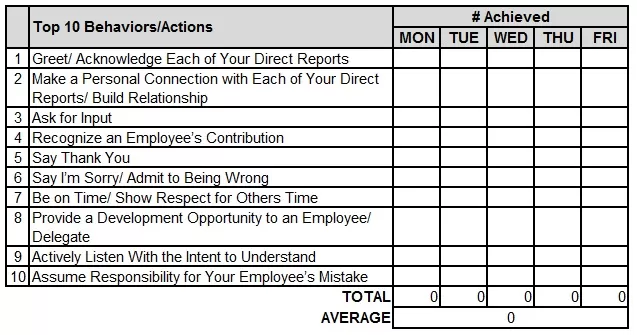 Implementing an employee engagement initiative can seem overwhelming for some companies. This post will look at how managers can begin to hold themselves accountable for achieving daily points of engagement with their direct reports.
Implementing an employee engagement initiative can seem overwhelming for some companies. This post will look at how managers can begin to hold themselves accountable for achieving daily points of engagement with their direct reports.
“Today, driven by shifts in both work ethos and the transparency of the job market, employee retention and engagement are now the #1 problems companies face.”1 According to Deloitte, “87 percent of organizations cite culture and engagement as one of their top challenges, and 50 percent call the problem “very important.”2 “Only 7 percent rate themselves excellent at measuring, driving, and improving engagement and retention.”3
In an earlier Agent In Engagement post, “Employee Engagement: Where to Start?,” we learned that companies can increase the effectiveness of their employee engagement efforts by targeting their managers. According to Gallup, “Managers account for 70% of variance in employee engagement.”4
Given that, we are again back to the question of where to begin?
Let’s start with the Daily Points of Engagement Checklist. This goal of this tool is to prompt managers to focus on employee engagement by providing specific behaviors/actions on which to concentrate.
Daily Points of Engagement

The behaviors/actions listed on the Daily Points of Engagement are suggestions. You can modify the list to best fit your employees’ needs. As your day progresses, score yourself on the number of times you demonstrate the behaviors or take the actions listed in the Daily Points of Engagement Tool. Give yourself one point each time those behaviors/actions are achieved. At the end of each day, add up your score.
After the first week, determine your baseline score by taking the average of your five daily scores. Once you have the baseline established, set a stretch goal for the number of daily points of engagement you want to achieve each day. As you progress, you may notice that you have incorporated a behavior/action as a normal part of your daily routine. If so, replace it with an additional behavior/action on which you should focus.
Given that you are tracking your behaviors/actions on a daily basis, you will be able to monitor your progress by day, week, month, and year using the tool template. As you progress, be sure to reward yourself. Determine specific rewards and designated milestones.
Remember, engagement impacts every employee. “I don’t know any manager that wouldn’t want people to come to work more often, reduce turnover, have fewer things stolen from the business, improve quality, and reduce safety issues…all while seeing a boost in customer satisfaction, productivity, and profit.”5
For those of you who are competitive, want some extra credit? With the Daily Points of Engagement, you are focusing on better engaging your employees. Ponder YOUR engagement by tracking your responses to Marshall Goldsmith’s Six Engaging Questions6:
- Did I do my best to set clear goals?
- Did I do my best to make progress toward goal achievement?
- Did I do my best to be happy?
- Did I do my best to find meaning?
- Did I do my best to build positive relationships?
- Did I do my best to be fully engaged?
What are your thoughts on the Daily Points of Engagement? What behaviors/actions will you include on your checklist?
1 Bersin, Josh. “Engagement, Retention, and Culture Now the #1 Issues in Talent and HR.” Bersin by Deloitte. Deloitte Development LLC, 10 Mar. 201. Web. 24 Feb. 2016. <http://www.bersin.com/blog/post/Engagement2c-Retention2c-and-Culture-now-the-1-Issue-in-Talent-and-HR.aspx>.
2 Brown, David, Sonny Chheng, Veronica Melian, Kathy Parker, and Marc Solow. “Culture and Engagement: The Naked Organization.” Deloitte University Press. Deloitte Development LLC, 27 Feb. 2015. Web. 13 Apr. 2016. P. 35. <http://dupress.com/articles/employee-engagement-culture-human-capital-trends-2015/>.
3 Ibid., P. 36.
4 Beck, Randall, and James Harter. “Managers Account for 70% of Variance in Employee Engagement.” Gallup.com. Gallup, Inc., 2 Apr. 2015. Web. 17 Mar. 2016.<http://www.gallup.com/businessjournal/182792/managers-account-variance-employee-engagement.aspx>.
5 “Gallup Employee Engagement: What You Need to Know.” GetLighthouse. Get_LIghthouse, 2015. Web. 21 Apr. 2016. <https://getlighthouse.com/blog/gallup-employee-engagement-survey-managers/>.
6 Goldsmith, Marshall, and Mark Reiter. Triggers: Creating Behavior That Lasts– Becoming the Person You Want to Be. Crown Business, 2015. Print. P. 111-114
Let’s Engage!
I’m Agent in Engagement Simpson…Gregory F Simpson.
Employee engagement is a critical mission. I hope I can count on your help! Subscribe to the RSS Feed to receive the latest intelligence/insights and/or register to make entries in the comments log.
 You can follow me @agtinengagement.
You can follow me @agtinengagement.
Email me at g…@a…t.com.
Connect via LinkedIn at LinkedIn.com/in/GregoryFSimpson.
Learn more about me at gregoryfsimpson.com.
P.S. First contact? Welcome to the Agent In Engagement community. Explore and join fellow employee engagement operatives in targeting a known thief – alias: Disengagement. Together we can bring this thief to justice and make the world a better place for all companies and their employees.
Other recent Agent in Engagement data/reports by Agent Gregory F Simpson:
- Employee Engagement Intelligence Briefing: 2016.04.11 – 2016.04.15
- Veteran Operative Employee Engagement Insights: 04.11 – 2016.04.15
- How to Avoid Paying an Unnecessary Procrastination Tax to the IRS
- Get in the Driver’s Seat and Shift
- Not Focusing on Employee Engagement is Madness
- Are You Committing Fouls or Scoring Employee Engagement Points?
- 16 Sweet Ways You Can Score With Employee Engagement